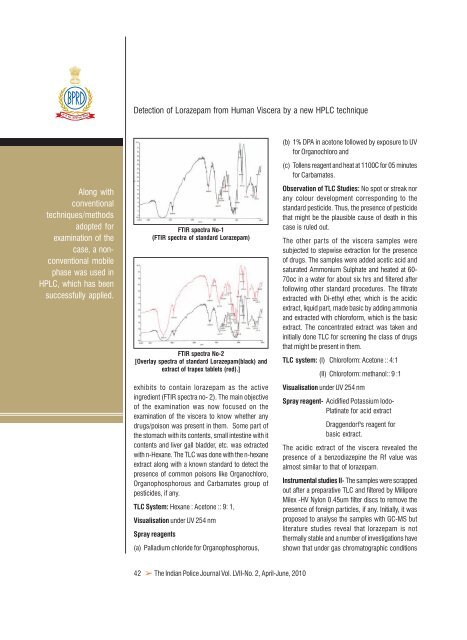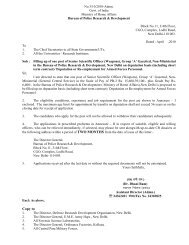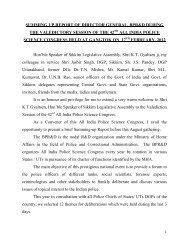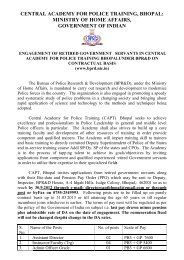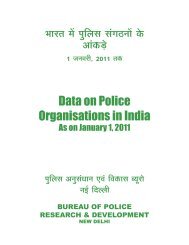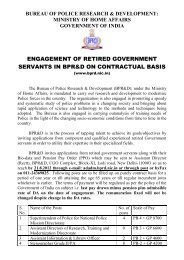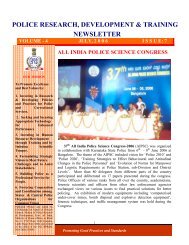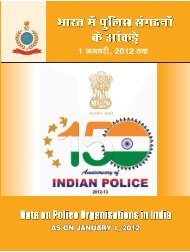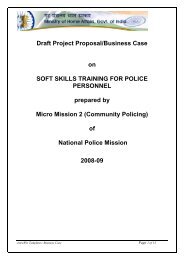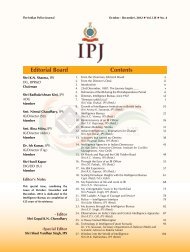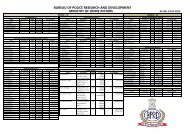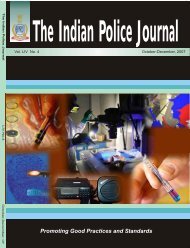April - June 2010 - Bureau of Police Research and Development
April - June 2010 - Bureau of Police Research and Development
April - June 2010 - Bureau of Police Research and Development
- No tags were found...
You also want an ePaper? Increase the reach of your titles
YUMPU automatically turns print PDFs into web optimized ePapers that Google loves.
Detection <strong>of</strong> Lorazepam from Human Viscera by a new HPLC technique(b) 1% DPA in acetone followed by exposure to UVfor Organochloro <strong>and</strong>(c) Tollens reagent <strong>and</strong> heat at 1100C for 05 minutesfor Carbamates.Along withconventionaltechniques/methodsadopted forexamination <strong>of</strong> thecase, a nonconventionalmobilephase was used inHPLC, which has beensuccessfully applied.FTIR spectra No-1(FTIR spectra <strong>of</strong> st<strong>and</strong>ard Lorazepam)FTIR spectra No-2[Overlay spectra <strong>of</strong> st<strong>and</strong>ard Lorazepam(black) <strong>and</strong>extract <strong>of</strong> trapex tablets (red).]exhibits to contain lorazepam as the activeingredient (FTIR spectra no- 2). The main objective<strong>of</strong> the examination was now focused on theexamination <strong>of</strong> the viscera to know whether anydrugs/poison was present in them. Some part <strong>of</strong>the stomach with its contents, small intestine with itcontents <strong>and</strong> liver gall bladder, etc. was extractedwith n-Hexane. The TLC was done with the n-hexaneextract along with a known st<strong>and</strong>ard to detect thepresence <strong>of</strong> common poisons like Organochloro,Organophosphorous <strong>and</strong> Carbamates group <strong>of</strong>pesticides, if any.TLC System: Hexane : Acetone :: 9: 1,Visualisation under UV 254 nmSpray reagents(a) Palladium chloride for Organophosphorous,Observation <strong>of</strong> TLC Studies: No spot or streak norany colour development corresponding to thest<strong>and</strong>ard pesticide. Thus, the presence <strong>of</strong> pesticidethat might be the plausible cause <strong>of</strong> death in thiscase is ruled out.The other parts <strong>of</strong> the viscera samples weresubjected to stepwise extraction for the presence<strong>of</strong> drugs. The samples were added acetic acid <strong>and</strong>saturated Ammonium Sulphate <strong>and</strong> heated at 60-70oc in a water for about six hrs <strong>and</strong> filtered afterfollowing other st<strong>and</strong>ard procedures. The filtrateextracted with Di-ethyl ether, which is the acidicextract, liquid part, made basic by adding ammonia<strong>and</strong> extracted with chlor<strong>of</strong>orm, which is the basicextract. The concentrated extract was taken <strong>and</strong>initially done TLC for screening the class <strong>of</strong> drugsthat might be present in them.TLC system: (I) Chlor<strong>of</strong>orm: Acetone :: 4:1(II) Chlor<strong>of</strong>orm: methanol:: 9 :1Visualisation under UV 254 nmSpray reagent- Acidified Potassium Iodo-Platinate for acid extractDraggendorf's reagent forbasic extract.The acidic extract <strong>of</strong> the viscera revealed thepresence <strong>of</strong> a benzodiazepine the Rf value wasalmost similar to that <strong>of</strong> lorazepam.Instrumental studies II- The samples were scrappedout after a preparative TLC <strong>and</strong> filtered by MilliporeMilex -HV Nylon 0.45um filter discs to remove thepresence <strong>of</strong> foreign particles, if any. Initially, it wasproposed to analyse the samples with GC-MS butliterature studies reveal that lorazepam is notthermally stable <strong>and</strong> a number <strong>of</strong> investigations haveshown that under gas chromatographic conditions42 ➢ The Indian <strong>Police</strong> Journal Vol. LVII-No. 2, <strong>April</strong>-<strong>June</strong>, <strong>2010</strong>


